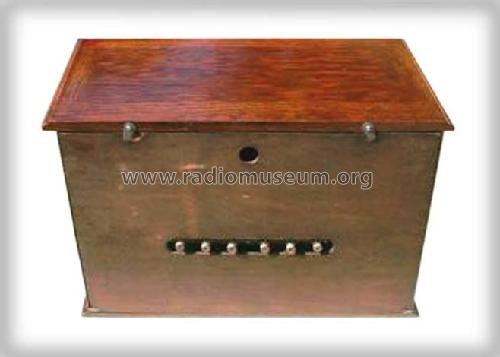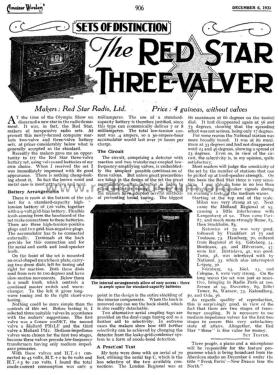Red Star
Red Star; Birmingham
- Country
- Great Britain (UK)
- Manufacturer / Brand
- Red Star; Birmingham
- Year
- 1930
- Category
- Broadcast Receiver - or past WW2 Tuner
- Radiomuseum.org ID
- 77628
- Number of Tubes
- 3
- Main principle
- TRF with regeneration
- Wave bands
- Broadcast, Long Wave and Short Wave.
- Power type and voltage
- Storage and/or dry batteries / 2, 9, 120 Volt
- Loudspeaker
- - For headphones or amp.
- Material
- Wooden case
- from Radiomuseum.org
- Model: Red Star - Red Star; Birmingham
- Shape
- Tablemodel, Box - most often with Lid (NOT slant panel).
- Dimensions (WHD)
- 16 x 10.5 x 8 inch / 406 x 267 x 203 mm
- Notes
-
The Red Star Three Valver
There is nothing cheap looking about it. In fact, the brown wood and metal case is most attractive and neat.
Battery Arrangements
There is room at the bottom of the cabinet for a standard-capacity high-tension battery of 120 volts, together with a 9-volt grid-bias battery. Flexible leads coming from the baseboard of the set make connections to these batteries. There are three high-tension positive plugs and two grid-bias negative plugs. The accumulator has to be connected externally. Terminals at the back provide for this connection and for the aerial and earth and loudspeaker leads.
On the front of the set is mounted an oval-shaped escutcheon plate, carrying two drum dials, left for tuning and right for reaction. Both these dials read from zero to 100 degrees and have slow-motion movements. Below them is a small knob, which controls a combined master switch and wave changer. To the left it gives long-wave tuning and to the right short-wave tuning.
Nothing could be simpler than the controls of this set. Before testing it, I selected three suitable valves in accordance with the maker's suggestions.
The first valve was a Cossor 210DET, the second valve a Mullard PM1LF, and the third valve a Mullard PM2. Medium-impedance valves were chosen for the first two stages because these valves precede low-frequency transformers having only medium-impedance primaries.
With these valves. and HT+1 connected to 45 volts, HT+2 to 80 volts, and HT+3 to 120 volts, I found the total anode-current consumption was only 9 milliamperes.
The use of a standard capacity battery is therefore justified since this type can economically deliver 7 or 8 milliamperes. The total low-tension current was 4 ampere, so a 30-ampere-hour accumulator would last over 70 hours per charge.The circuit
Comprising a detector with reaction and two transformer-coupled low frequency-amplifying valves is undoubtedly the simplest possible combination of three valves. But unless great precautions are taken in the design of the set the great magnification after detection is liable to cause unselective tuning. Knowing this, the makers have adopted several methods of preventing broad, tuning. The biggest point in the design is the entire shielding of the interior components. When the back is removed one can see the back shield, which is also readily detachable.
Two alternative aerial coupling taps are provided on the dual range tuning coil as a further aid to selectivity. In extreme cases, the makers show how still further selectivity can be achieved by changing the detector from the leaky-grid-condenser system to a form of anode-bend detection.
Price: 4 guineas, without valves
- Price in first year of sale
- 4.00 GNS
- Source of data
- Radio! Radio!
- Mentioned in
- -- Original prospect or advert (Amateur Wireless & Wireless Dec 6, 1930 Page 906)
- Literature/Schematics (1)
- -- Schematic
- Author
- Model page created by Konrad Birkner † 12.08.2014. See "Data change" for further contributors.
- Other Models
-
Here you find 2 models, 2 with images and 0 with schematics for wireless sets etc. In French: TSF for Télégraphie sans fil.
All listed radios etc. from Red Star; Birmingham



